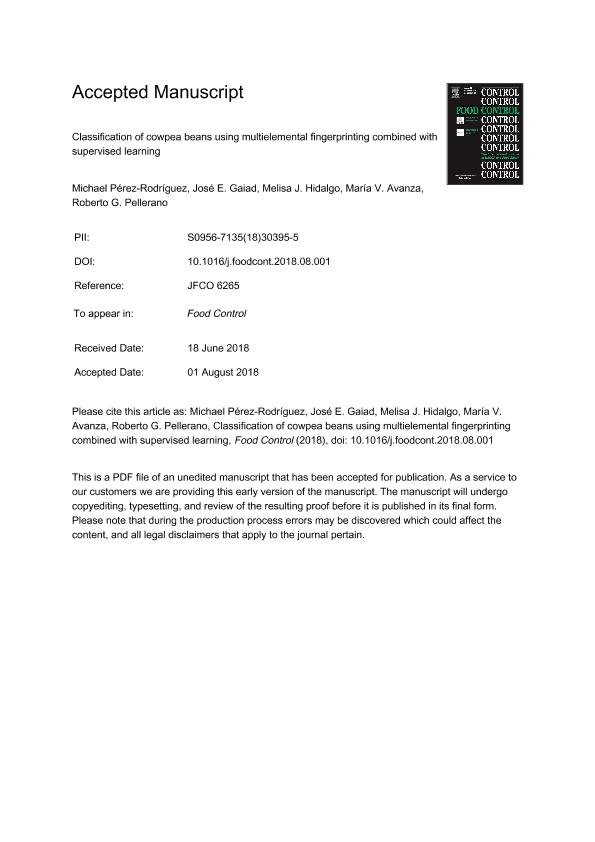Artículo
Classification of cowpea beans using multielemental fingerprinting combined with supervised learning
Pérez Rodríguez, Michael ; Gaiad, José Emilio
; Gaiad, José Emilio ; Hidalgo, Melisa Jazmin
; Hidalgo, Melisa Jazmin ; Avanza, María Victoria
; Avanza, María Victoria ; Pellerano, Roberto Gerardo
; Pellerano, Roberto Gerardo
 ; Gaiad, José Emilio
; Gaiad, José Emilio ; Hidalgo, Melisa Jazmin
; Hidalgo, Melisa Jazmin ; Avanza, María Victoria
; Avanza, María Victoria ; Pellerano, Roberto Gerardo
; Pellerano, Roberto Gerardo
Fecha de publicación:
01/2019
Editorial:
Elsevier
Revista:
Food Control
ISSN:
0956-7135
Idioma:
Inglés
Tipo de recurso:
Artículo publicado
Clasificación temática:
Resumen
Multielemental compositions (Ag, As, Ba, Be, Cd, Cs, Co, Cr, Cu, Mo, Ni, Pb, Sb, Se, Sn, Sr, Tl, Rb, V, and Zn) of 106 cowpea bean samples belonging to different varieties collected from the province of Corrientes in Argentina were determined using inductively coupled plasma mass spectrometry (ICP-MS). Based on the multielemental data, five supervised learning techniques, namely, linear discriminant analysis (LDA), partial least square discriminant analysis (PLS-DA), k nearest neighbors (k-NN), random forest (RF), and support vector machine (SVM) with radial basis function Kernel, were computed aiming at building classification models that allow one to predict the botanical variety of the samples based on their element profiles. The best classification performance was obtained by SVM with 93% accuracy rate. The model developed through this method enabled the correct separation of the samples into the five cowpea varieties investigated, where 100% sensitivity was achieved for most of the predicted classes. Thus, SVM was the algorithm selected for the classification of the cowpea beans according to their botanical variety. Multielemental determination coupled with supervised pattern recognition techniques have proved to be an interesting approach for differentiating a diverse range of cowpea genotypes. This study has contributed toward generalizing the use of multielemental fingerprinting as a promising tool for testing the authenticity of cowpea beans on a global scale.
Archivos asociados
Licencia
Identificadores
Colecciones
Articulos(IQUIBA-NEA)
Articulos de INSTITUTO DE QUIMICA BASICA Y APLICADA DEL NORDESTE ARGENTINO
Articulos de INSTITUTO DE QUIMICA BASICA Y APLICADA DEL NORDESTE ARGENTINO
Citación
Pérez Rodríguez, Michael; Gaiad, José Emilio; Hidalgo, Melisa Jazmin; Avanza, María Victoria; Pellerano, Roberto Gerardo; Classification of cowpea beans using multielemental fingerprinting combined with supervised learning; Elsevier; Food Control; 95; 1-2019; 232-241
Compartir
Altmétricas



